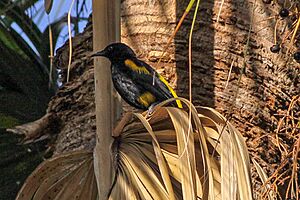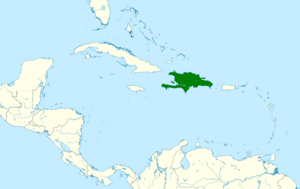Hispaniolan oriole facts for kids
Quick facts for kids Hispaniolan oriole |
|
|---|---|
 |
|
| Conservation status | |
| Scientific classification | |
 |
|
| Synonyms | |
|
Oriolus dominicensis Linnaeus, 1766 |
The Hispaniolan oriole (Icterus dominicensis) is a beautiful bird found only on the Caribbean island of Hispaniola. This island is shared by two countries: the Dominican Republic and Haiti. It belongs to the Icteridae family, which includes many types of orioles and blackbirds.
Contents
About the Hispaniolan Oriole's Name
For a long time, scientists thought the Hispaniolan oriole was part of a larger group of orioles. This group included the Cuban oriole, the Bahama oriole, and the Puerto Rican oriole.
However, in 2010, bird experts decided that these four birds were different enough to be their own separate species. So, the Hispaniolan oriole is now recognized as a unique species. Its scientific name, Icterus dominicensis, was first given by Carl Linnaeus in 1766.
What Does the Hispaniolan Oriole Look Like?
The Hispaniolan oriole is a sleek, black and yellow bird. It has a thin beak and no white marks on its wings. This bird shows more yellow than most other Caribbean orioles, except for the Bahama oriole.
- Adults: Both male and female adult orioles are mostly black. They have bright yellow patches on their shoulders, lower back, and under their tail. These yellow patches can even reach their lower chest.
- Young Birds: Young Hispaniolan orioles have olive-colored upper parts. Their undersides are a dull yellow. Their wings are black, and their throat might be black or reddish-brown.
- Size: These orioles are about 20–22 cm (8–9 inches) long. Males usually weigh 35–38 grams, while females weigh 33–40 grams.
People sometimes confuse this bird with the yellow-shouldered blackbird. However, the blackbird only has yellow patches on its shoulders.
Hispaniolan Oriole Sounds
The Hispaniolan oriole makes a sharp keck or check sound. Its song is not heard very often. When it does sing, it's a series of high-pitched whistles.
The song is usually heard right after sunrise. It is almost never heard during the day. This is similar to the Puerto Rican oriole. While female orioles of other species are known to sing, scientists have not yet identified songs from female Hispaniolan orioles.
Where the Hispaniolan Oriole Lives
The Hispaniolan oriole lives all year round on the island of Hispaniola. This includes both the Dominican Republic and Haiti. It also lives on nearby islands like Gonâve, Saona, and Tortuga.
These birds like to live in tropical and subtropical forests. They can also be found at the edges of forests, in woodlands, and in gardens. They live from the coast up to mid-level mountain areas. However, they are not as common at very high elevations.
You can often find them where there are palm trees, as they use palm fronds for nesting. They also live in the many shaded coffee farms on the island.
What the Hispaniolan Oriole Eats
The Hispaniolan oriole enjoys a varied diet. It eats fruits, insects, flowers, and nectar. They often drink nectar from the Erythrina plant.
These clever birds can even hang upside-down to reach food or insects. They do this to find treats on the underside of leaves. They usually look for food in thick plants and trees.
Hispaniolan Oriole Reproduction
The Hispaniolan oriole's main breeding season is from March to June. However, they can sometimes breed at other times of the year too.
- Eggs: Their eggs are white with a light blue tint. They also have dark brown spots. A female usually lays about 3 eggs at a time.
- Nests: They often build their nests on the underside of banana trees or palm fronds. The nest is like a hanging basket. It is carefully woven from fine plant fibers, mostly from palm leaves.
When young orioles are old enough to live on their own, their body feathers and wing feathers are replaced.
Protecting the Hispaniolan Oriole
The Hispaniolan oriole is listed as "Least Concern" on the IUCN Red List. This means that its population is not currently in danger. Even though there haven't been official counts of how many there are, many people have seen these orioles all over the island.
However, there is a chance their numbers could go down. This is because of a bird called the shiny cowbird. Shiny cowbirds sometimes lay their eggs in the nests of other birds, like the Hispaniolan oriole. The orioles then raise the cowbird chicks instead of their own. Scientists have noted that Hispaniolan orioles are often chosen by cowbirds to host their eggs.


